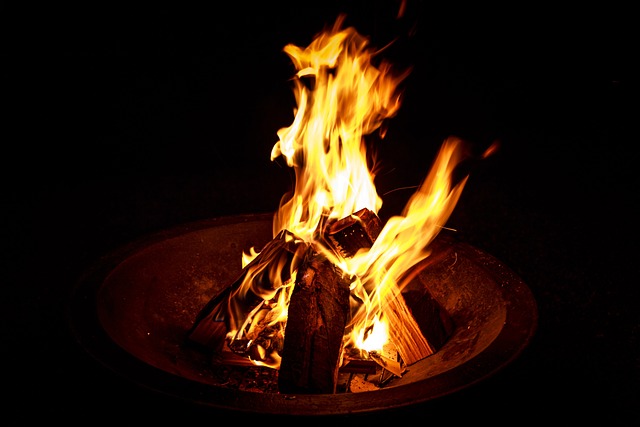If you’re like me, you love the cozy and magical atmosphere that a fire pit creates. But did you know that there are options beyond traditional wood to fuel your fire pit? That’s right!
When it comes to fueling your fire pit, there are a variety of options that go beyond wood. One such alternative is switchgrass and soy logs. These logs, made from a 50% blend of soybeans and switchgrass, utilize natural wax as a binder. Not only are they safe to burn, but they also leave no residue in your fire pit. As an added bonus, they emit a delightfully sweet scent while they burn. So, alongside traditional wood, you can explore the versatility of charcoal, the convenience of propane, the eco-friendliness of bioethanol, and the aromatic experience of switchgrass and soy logs.
Keep reading below. Let’s explore the wonderful world of alternative fire pit fuels, opening up a whole new range of possibilities for your outdoor gatherings. So, grab a seat, get comfortable, and let’s find out what else you can burn in a fire pit besides wood!
Understanding Fire Pit Basics
When it comes to understanding fire pit basics, there are a few key elements to consider. First and foremost, safety should always be the top priority. Ensure you have a safe location for your fire pit and follow any local regulations or guidelines.
In terms of functionality, fire pits work by providing a contained space for controlled fires. They typically consist of a sturdy base, walls, and a means to ventilate the fire, such as a mesh screen or an open area. The choice of fuel is crucial in determining the intensity and characteristics of the fire.
The most common fuel for fire pits is wood. It creates a warm and cozy ambiance with crackling sounds and aromatic scents. Hardwoods like oak, maple, and birch are popular choices due to their long burn times and higher heat output. Softwoods like pine and cedar, while burning faster, offer quick ignition and pleasant fragrances.
However, beyond wood, there are alternative fuels you can use in your fire pit. These include charcoal, which provides versatility and longer burn times and can be easily ignited. Propane and natural gas fire pits offer convenience, as they require no preparation or cleanup. Bioethanol, an eco-friendly fuel made from plant-based sources, burns cleanly without producing smoke or odor.
Additionally, dried biomass and pellets can be used as alternative fuels, providing an environmentally conscious option. If you’re looking to add a decorative touch, fire glass, and fire rocks are available, offering visual appeal while radiating heat.
Fire pit basics involve prioritizing safety, understanding how fire pits function, and choosing the right fuel to create the desired atmosphere for your outdoor gatherings.
Traditional Wood Options
When it comes to traditional wood options for your fire pit, there are a few choices that can bring warmth and charm to your outdoor space. Here are some popular options:
- Hardwoods: Hardwoods like oak, maple, and birch are excellent choices for a traditional wood-burning fire pit. They burn longer and produce more heat, making them perfect for those cool evenings when you want to stay cozy and warm. Hardwoods also tend to create beautiful embers that add to the overall enchantment of your fire pit experience.
- Softwoods: Softwoods such as pine and cedar are also commonly used in fire pits. While they may burn faster than hardwoods, they ignite quickly and release a pleasant aroma that can enhance the ambiance of your outdoor gathering. Softwoods are great for creating a cozy and inviting atmosphere.
Remember, it’s important to use properly seasoned or dry wood in your fire pit. Moist or green wood can create excessive smoke and may not burn efficiently. To ensure a better fire, make sure your wood has been properly seasoned and has a low moisture content.
Whether you choose hardwoods or softwoods, traditional wood options can provide a classic and comforting fire pit experience. Just be sure to follow safety guidelines, keep a close eye on the fire, and enjoy the crackling sounds and soothing warmth that wood fires bring to your outdoor space.
Alternative Fire Pit Fuels
While wood is a classic choice for fire pit fuel, there are actually several alternatives that can add a new level of convenience, cleanliness, and even eco-friendliness to your fire pit experience. Let’s explore some of these exciting options:
1. Switchgrass and Soy Logs:
Another non-wood option is switchgrass and soy logs. These logs are a 50% blend of soybeans and switchgrass, using natural wax as a binder. These logs are safe to burn and do not leave any residue in your fire pit. Plus, they leave a sweet scent as they burn. Alongside traditional wood, you can explore the versatility of charcoal, the convenience of propane, the eco-friendliness of bioethanol, and the aromatic experience of switchgrass and soy logs. Elevate your fire pit gatherings with the warmth, ambiance, and enchanting fragrance they bring to your outdoor space.
2. Charcoal:
The Versatile Choice If you’re looking for a fuel that offers versatility and longer burn times, charcoal is a fantastic option. It’s readily available, easy to ignite, and produces a steady and consistent heat. Charcoal also creates less smoke and ash compared to wood, making cleanup a breeze. You can choose from traditional charcoal briquettes or opt for natural lump charcoal for a more authentic and flavorful grilling experience.
3. Propane and Natural Gas:
Convenience and Cleanliness For the ultimate convenience and hassle-free fire pit experience, you can consider using propane or natural gas. These fuels offer instant ignition and precise control over the flame. With a simple turn of a knob, you can adjust the flame height to your liking. Propane and natural gas also burn clean, leaving no ashes or debris behind, which means less cleanup for you.
4. Eco-Friendly Bioethanol:
If environmental consciousness is a priority for you, bioethanol is a fantastic eco-friendly option. Bioethanol is a renewable fuel made from plant-based sources like corn or sugarcane. It burns clean, producing no smoke or soot, and doesn’t require any ventilation. Bioethanol fire pits come in various stylish designs, allowing you to enjoy a beautiful flame without the need for wood or gas.
5. Dried Biomass and Pellets:
Another alternative fuel worth considering is dried biomass or pellets. Biomass refers to organic matter like corn husks, dried fruit pits, or nutshells. When properly dried and prepared, they can be used as an eco-friendly fuel option for your fire pit. Pellets, made from compacted sawdust or wood shavings, are also a popular choice. They burn efficiently and produce a consistent flame, making them a great option for longer burn times.
6. Decorative Fire Glass and Fire Rocks:
If you’re looking to add a touch of style and uniqueness to your fire pit, decorative fire glass or fire rocks are an excellent option. These colorful, heat-resistant glass pieces or rocks can replace traditional fuel altogether, creating a stunning visual effect as the flames dance over them. Not only do they add a decorative element, but they also radiate heat, making your fire pit experience even more enjoyable.
What Not to Burn in a Fire Pit
Now that we’ve explored the exciting world of alternative fire pit fuels, it’s crucial to discuss what you should never burn in a fire pit. Safety and environmental responsibility should always be a priority when enjoying your fire pit. Here are some materials you should avoid burning:
Hazardous Materials:
-
- Plastics: Burning plastics can release toxic fumes and harmful chemicals into the air.
- Treated or painted wood: These types of wood often contain chemicals that can produce harmful smoke and ash.
- Rubber or synthetic materials: Burning rubber or synthetic materials can create noxious fumes that are harmful to inhale.
- Styrofoam: This material is not only harmful when burned but also produces large amounts of black smoke.
Environmental Impact:
-
- Green or wet wood: Burning unseasoned or wet wood can create excessive smoke and produce a less enjoyable fire.
- Trash or household waste: Burning trash can release pollutants into the air and harm the environment.
- Leaves or yard waste: Burning leaves can contribute to air pollution and is often prohibited in many areas due to the risk of uncontrolled fires.
- Pressure-treated wood: Avoid burning pressure-treated wood as it contains chemicals that can be harmful when burned.
It’s important to be mindful of what you put in your fire pit to protect your health, and the environment, and to ensure a safe and enjoyable experience for everyone.
Final Thoughts
In conclusion, when it comes to fueling your fire pit, the possibilities are truly diverse and exciting. Beyond the traditional choice of wood, you can explore a range of alternatives that offer unique benefits and experiences. From the versatility of charcoal to the convenience of propane, the eco-friendliness of bioethanol, and the enchanting fragrance of switchgrass and soy logs, there is a fuel option to suit every preference and occasion.
By embracing these alternatives, you can elevate your fire pit gatherings, creating a warm and inviting ambiance while minimizing residue and enjoying delightful scents. So, let your imagination ignite as you discover the various fuels available and make your fire pit experience truly extraordinary.
You may also be interested in reading this next: Can You Burn Wood In Your Garden? Exploring The Benefits, Risks, And Alternatives





